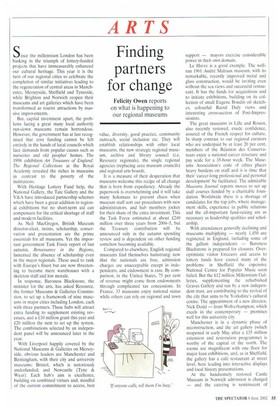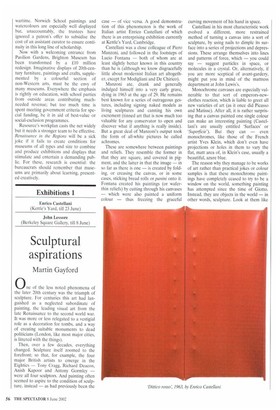Finding partners for change
Felicity Owen reports on what is happening to our regional museums Since the millennium London has been basking in the triumph of lottery-funded projects that have immeasurably enhanced our cultural heritage. This year it is the turn of our regional cities to celebrate the completion of similar initiatives leading to the regeneration of central areas in Manchester, Merseyside, Sheffield and Tyneside, while Brighton and Norwich reopen their museums and art galleries which have been transformed as tourist attractions by massive improvements.
But, capital investment apart, the problems facing a great many local authority run-down museums remain horrendous. However, the government has at last recognised that core funding cannot be left entirely in the hands of local councils which face demands from popular causes such as nurseries and old peoples' homes. The 1998 exhibition Art Treasures of England: The Regional Collections at the Royal Academy revealed the riches in museums in contrast to the poverty of the institutions.
With Heritage Lottery Fund help, the National Gallery, the Tate Gallery and the V&A have introduced partnership schemes which have been a great addition to regional exhibitions but no short-term aid can compensate for the critical shortage of staff and modern facilities, As Neil MacGregor, British Museum director-elect, insists, scholarship, conservation and presentation are the prime essentials for all museums. Yet the important government Task Force report of last autumn, Renaissance in the Regions, lamented the absence of scholarship even in the major regionals. These used to rank with Europe's finest but are now threatening to become mere warehouses with a skeleton staff and low morale.
In response, Baroness Blackstone, the minister for the arts, has asked Resource. the former Museums & Galleries Commission, to set up a framework of nine museums in major cities including London, each with three partners. These hubs will attract extra funding to supplement existing revenues, and a £10 million grant this year and £20 million the next to set up the system. The combinations selected by an independent panel will be announced later in the year.
With Liverpool happily covered by the National Museums & Galleries on Merseyside, obvious leaders are Manchester and Birmingham, with their city and university museums; Bristol, which is notoriously underfunded; and Newcastle (Tyne & Wear). Each hub's aim is excellence, building on combined virtues and, mindful of the current commitment to access, best value, diversity, good practice, community outreach, social inclusion etc. They will establish relationships with other local museums, the new strategic regional museum, archive and library council (i.e. Resource regionals), the single regional agencies (replacing area museum councils) and regional arts boards.
It is a measure of their desperation that museums welcome this recipe of all change that is born from expediency. Already the paperwork is overwhelming and it will take many Solomans to prevent chaos when museum staff sort out procedures with new administrators, and hub members jockey for their share of the extra investment. This the Task Force estimated at about £240 million over three years from 2004-5, but the Treasury contribution will be announced only in the autumn spending review and is dependent on other funding somehow becoming available.
Compared to elsewhere. English regional museums find themselves hamstrung: now that the nationals are free, admission charges are unacceptable except in independents, and endowment is rare. By comparison, in the United States, 75 per cent of revenue might come from endowments through complicated tax concessions. In France. 33 museums enjoy national status while others can rely on regional and town support — mayors exercise considerable power in their own domain, Le Havre is a good example. The wellrun 1961 Andre Malraux museum, with its remarkable, recently improved metal and glass construction, would be inviting even without the sea views and successful restaurant. It has the funds for acquisitions and to initiate exhibitions, building on its collection of small Eugene Boudin oil sketches, colourful Raoul Dufy views and interesting cross-section of Post-Impressionists.
The great museums in Lille and Rouen, also recently restored, exude confidence, assured of the French respect for culture.
In sharp contrast to our regional curators who are underpaid by at least 20 per cent, members of the Reunion des Conseiva teurs enjoy a national career structure and pay scale for a 35-hour week. The Muse ums Association's code of ethics places heavy burdens on staff and it is time that their career-long professional and personal development' be facilitated. The admirable Museums Journal reports moves to set up staff courses funded by a charitable foun dation. Worldwide there is a shortage of candidates for the top jobs, where management skills, experience in public relations and the all-important fund-raising are as necessary as leadership qualities and scholarship.
With attendances generally declining and museums multiplying — nearly 1,450 are registered in England, including some of the gallant independents — Baroness Blackstone is prepared for closures. Over optimistic visitor forecasts and access to lottery funds have caused many of the problems: in Sheffield the expensive National Centre for Popular Music soon failed. But the £12 million Millennium Galleries, supplementing the refurbished Graves Gallery and run by a new indepen dent trust, are contributing to the revival of the city that aims to be Yorkshire's cultural centre. The appointment of a new director, Nick Dodd — from Wolverhampton, which excels in the contemporary promises well for this university city.
Manchester is in a dynamic phase of reconstruction, and the art gallery (which reopened in early May after a £35 million extension and restoration programme) is worthy of the capital of the north. The rooms are magnificent with one floor for major loan exhibitions, and, as in Sheffield, the gallery has a café restaurant at street level, here leading into interactive displays and local history presentations.
At the handsomely restored Castle Museum in Norwich admission is charged — and the catering is reminiscent of wartime. Norwich School paintings and watercolours are especially well displayed but, unaccountably, the trustees have ignored a patron's offer to subsidise the cost of an assistant curator to ensure continuity in this long line of scholarship.
Now with a welcoming entrance from Pavilion Gardens, Brighton Museum has been transformed by a 10 million redesign. Imaginative displays of 20th-century furniture, paintings and crafts, supplemented by a colourful section of non-Western arts, must be the envy of many museums. Everywhere the emphasis is rightly on education, with school parties from outside areas contributing muchneeded revenue; but too much time is spent meeting government criteria for special funding, be it in aid of best-value or social-exclusion programmes.
Resource's workplan casts the net widely but it needs a stronger team to be effective. Renaissance in the Regions will be a sick joke if it fails to create conditions for museums of all types and size to combine and produce exhibitions and displays that stimulate and entertain a demanding public. For these, research is essential: the bureaucrats should remember that museums are primarily about learning, presented creatively.























































































 Previous page
Previous page